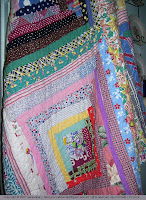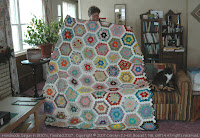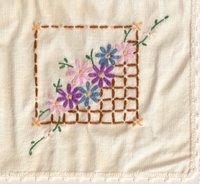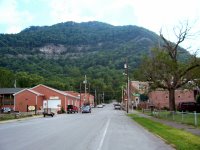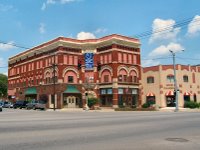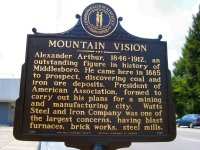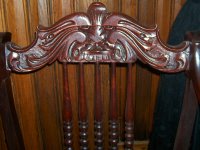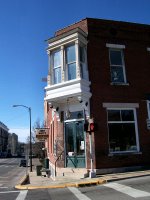Another Trip Down Memory Lane... Life in Christian County, Kentucky...
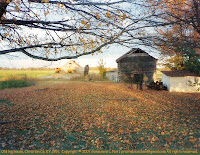
When we bought our small country acreage, there was an old log house in the yard. The log house (with an added wing) was the farmhouse before the house that we currently live in was built. For those who may be wondering, this log house was built by a Harned, but I don't know the first name.
Today, I came across a couple photos taken about the first of October in 1991 that show the log house. We had been here for about a month when the photos were taken. The photo above looks east from our house. A lot of old metal and trash was piled around the yard then, and some of it is visible beside the little white shed at right.
The old log house, or "log room" as the former owners called it, was full of junk also. There were cans and bags of unidentified powders, rusty cans of dried up paint, stacks of old newspapers, boxes of chipped and broken kitchen dishes, old boards with rusty nails, piles of rags and old rugs, broken windows, and so on.
Of course, we found a few interesting things in it as well. Old tools were piled in one corner, including some antique picks and axes with handmade handles. One old box yielded some vintage milk bottles and aqua-colored canning jars. On a nail in the wall, we found clothes hangers made of curved tree branches with wires bent around them. We also saved a few old wooden crates, an odd-sized handmade wooden door, and an ornate headboard.
If you look closely at the photo, you'll see that a chimney is standing out in the yard near the log house. It was once on the outer wall of an addition to the original house. The original house had a big fireplace on the eastern wall, opposite the door that's visible in the photo.
The whole house was covered with wood siding at one time and painted white, and thus some of the older neighbors still reminisce about the "white house" on this place. This may have been done at the time the addition was added to the north side of the cabin.
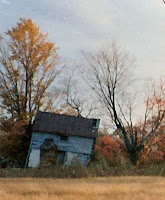
When the previous owner of the property built a new house in the early 1960's, he tore off the addition on the old house and left just the "log room" standing. By the time we moved here, the plank floor of the log house was rotten in places and the northwest corner was sagging dangerously due to weather-related deterioration of the logs. The second floor of the house had an uncomfortable slant to the northwest.
The next spring, a great-great grandson of the log house's builder approached us. He wanted to tear down the house and salvage the logs. He had recently torn down a log house built by another ancestor, and he intended to use the good logs from the two houses to add a log room to an old house he was renovating. (This fellow is a carpenter by trade as well as being a good general handyman, as many country folk are.)
We accepted his offer on the condition that he not only remove the house, but really clean up the whole area and haul off all the junk. I also stipulated that I would like to keep the stones from the chimneys that were small enough for me to lift.
So the log house and its chimneys were torn down and hauled a mile across the field to the old homesite that the gr-gr-grandson was rebuilding and restoring. Over the next couple years, he did indeed add a log room to the old house. He did a remarkable job of craftsmanship and soon had a comfortable, attractive, rustic home. We could see it plainly across the field, between us and Pilot Rock.
This story ends sadly. One Sunday morning as we got in the car to drive to church, we looked across the field and saw flames shooting as high as the treetops from this newly rebuilt house. An electrical problem (possibly caused by a squirrel chewing off the insulation on the wires) caused a fire in the attic. They tried to put it out themselves before finally calling the volunteer fire department. Then the first fire truck got stuck in the very rough muddy road leading to the home and blocked the way for all who came to help. Needless to say, the house burned to the ground.
Fortunately, everyone escaped without injury and they were able to salvage a few things from the home before the fire grew too dangerous. If there is a moral to the story, it would be to call the fire department right away if you have a fire, and even more importantly, to have a good enough road to your house that the fire truck can navigate it. Otherwise, you're on your own.

Technorati tag:
What do
you think? Comments are welcome!
 We had company over the 4th of July weekend -- Roger and Joy Hennen. We first met them in Berlin, Germany, about 20 years ago. They now live in Oklahoma, but they occasionally pass through Kentucky on their way home from visiting Roger's family in West Virginia.
We had company over the 4th of July weekend -- Roger and Joy Hennen. We first met them in Berlin, Germany, about 20 years ago. They now live in Oklahoma, but they occasionally pass through Kentucky on their way home from visiting Roger's family in West Virginia. I saw a sign in one of the stores that said something like "If you want it, buy it! It may not be here tomorrow." Maybe I should have done that. I saw a copy of the Family History Book, Christian County, Kentucky, the second volume of the most recent Christian County history books. It had a price tag of $60. I would like to have it but I was reluctant to pay that price.
I saw a sign in one of the stores that said something like "If you want it, buy it! It may not be here tomorrow." Maybe I should have done that. I saw a copy of the Family History Book, Christian County, Kentucky, the second volume of the most recent Christian County history books. It had a price tag of $60. I would like to have it but I was reluctant to pay that price. 








